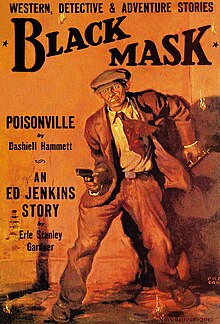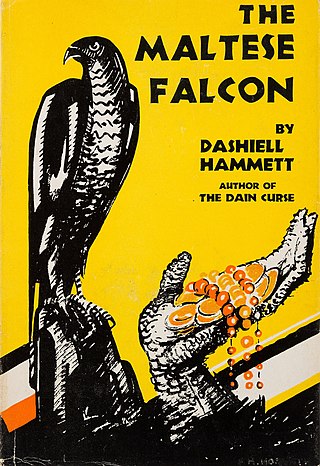
The Maltese Falcon is a 1930 detective novel by American writer Dashiell Hammett, originally serialized in the magazine Black Mask beginning with the September 1929 issue. The story is told entirely in external third-person narrative; there is no description whatsoever of any character's thoughts or feelings, only what they say and do, and how they look. The novel has been adapted several times for the cinema.

Samuel Dashiell Hammett was an American writer of hard-boiled detective novels and short stories. He was also a screenwriter and political activist. Among the characters he created are Sam Spade, Nick and Nora Charles, The Continental Op and the comic strip character Secret Agent X-9.
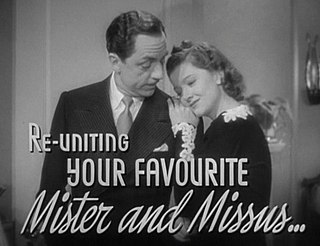
Nick and Nora Charles are fictional characters created by Dashiell Hammett in his novel The Thin Man. The characters were later adapted for film in a series of films between 1934 and 1947; for radio from 1941 to 1950; for television from 1957 through 1959; as a Broadway musical in 1991; and as a stage play in 2009.

Yojimbo is a 1961 Japanese samurai film directed by Akira Kurosawa, who also co-wrote the screenplay and was one of the producers. The film stars Toshiro Mifune, Tatsuya Nakadai, Yoko Tsukasa, Isuzu Yamada, Daisuke Katō, Takashi Shimura, Kamatari Fujiwara, and Atsushi Watanabe. In the film, a rōnin arrives in a small town where competing crime lords fight for supremacy. The two bosses each try to hire the newcomer as a bodyguard.
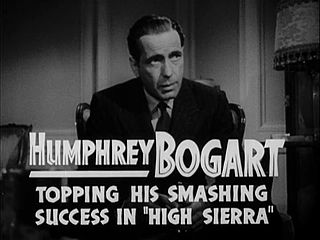
Sam Spade is a fictional character and the protagonist of Dashiell Hammett's 1930 novel The Maltese Falcon. Spade also appeared in four lesser-known short stories by Hammett.

A Fistful of Dollars is a 1964 spaghetti Western film directed by Sergio Leone and starring Clint Eastwood in his first leading role, alongside Gian Maria Volonté, Marianne Koch, Wolfgang Lukschy, Sieghardt Rupp, José Calvo, Antonio Prieto and Joseph Egger. The film, an international co-production between Italy, West Germany and Spain, was filmed on a low budget, and Eastwood was paid $15,000 for his role.
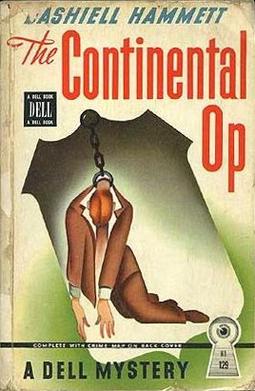
The Continental Op is a fictional character created by Dashiell Hammett. He is a private investigator employed as an operative of the Continental Detective Agency's San Francisco office. The stories are all told in the first person and his name is never given.
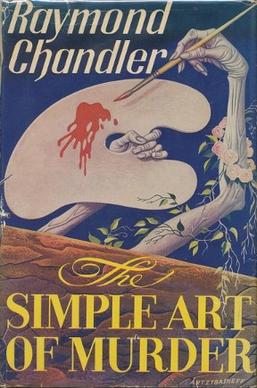
The Simple Art of Murder is the title of several quasi-connected publications by hard-boiled detective fiction author Raymond Chandler:
Hardboiled fiction is a literary genre that shares some of its characters and settings with crime fiction. The genre's typical protagonist is a detective who battles the violence of organized crime that flourished during Prohibition (1920–1933) and its aftermath, while dealing with a legal system that has become as corrupt as the organized crime itself. Rendered cynical by this cycle of violence, the detectives of hardboiled fiction are often antiheroes. Notable hardboiled detectives include Dick Tracy, Philip Marlowe, Nick Charles, Mike Hammer, Sam Spade, Lew Archer, Slam Bradley, and The Continental Op.

Blue City is a thriller written in 1947 by Ross Macdonald. The novel was originally released under his real name, Kenneth Millar, by Alfred A. Knopf, while a condensed version was serialized in the August and September 1950 issues of Esquire.

The Glass Key is a novel by American writer Dashiell Hammett. First published as a serial in Black Mask magazine in 1930, it then was collected in 1931. It tells the story of a gambler and racketeer, Ned Beaumont, whose devotion to Paul Madvig, a crooked political boss, leads him to investigate the murder of a local senator's son as a potential gang war brews. Hammett dedicated the novel to his onetime lover Nell Martin.

The Dain Curse is a novel by American writer Dashiell Hammett, published in 1929. Before its publication in book form, it was serialized in Black Mask magazine in 1928 and 1929.
On April 21, 1920, during a miners strike in Butte, Montana's copper mines, company guards fired on striking miners picketing near a mine of the Anaconda Copper Mining Company, killing Tom Manning and injuring sixteen others, an event known as the Anaconda Road massacre. His death went unpunished.
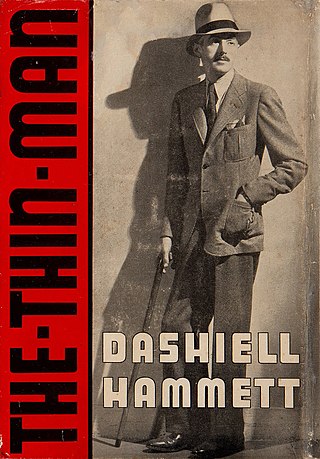
The Thin Man (1934) is a detective novel by Dashiell Hammett, originally published in a condensed version in the December 1933 issue of Redbook. It appeared in book form the following month. A film series followed, featuring the main characters Nick and Nora Charles, and Hammett was hired to provide scripts for the first two.
Carroll John Daly (1889–1958) was a writer of crime fiction. One of the earliest writers of hard-boiled fiction, he is best known for his detective character Race Williams, who appeared in a number of stories for Black Mask magazine in the 1920s.

The Glass Key is a 1942 American film noir based on the 1931 novel of the same name by Dashiell Hammett. The picture was directed by Stuart Heisler starring Brian Donlevy, Veronica Lake and Alan Ladd. A successful earlier film version starring George Raft in Ladd's role had been released in 1935. The 1942 version's supporting cast features William Bendix, Bonita Granville, Richard Denning and Joseph Calleia.
The Gutting of Couffignal (1925) is a hardboiled crime short story by Dashiell Hammett. It has been reprinted many times in different collections, namely: The Return of the Continental Op,The Big Knockover,Crime Stories and Other Writings, and The Big Book of the Continental Op.
Roadhouse Nights is a 1930 American pre-Code gangster film. A number of sources including Sally Cline in her book Dashiell Hammett Man of Mystery claim it is based on the classic novel Red Harvest written by Dashiell Hammett. However the credits of the film itself say only "An Original Screenplay by Ben Hecht." Hammett receives no mention at all.
Raoul Whitfield was an American writer of adventure, aviation, and hardboiled crime fiction. During his writing career, from the mid-1920s to the mid-1930s, Whitfield published over 300 short stories and serials in pulp magazines, as well as nine books, including Green Ice (1930) and Death in a Bowl (1931). For his novels and contributions to the Black Mask, Whitfield is considered one of the original members of the hard-boiled school of American detective fiction and has been referred as "the Black Mask's forgotten man".
La ciudad maldita is a 1978 Spanish-Italian Spaghetti Western murder mystery film directed by Juan Bosch. The film was written by Alberto De Stefanis, produced by José María Cunillés, scored by Franco Julian, and starring Diana Lorys, Luciano Pigozzi, Roberto Camardiel and Daniel Martín. It is based on the novel Red Harvest, by Dashiell Hammett, inspired in Yojimbo, by Kurosawa, and A Fistful of Dollars, by Sergio Leone.

